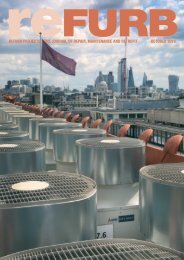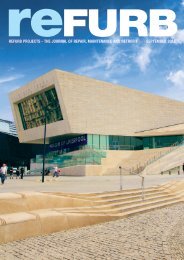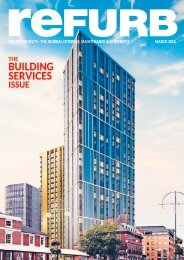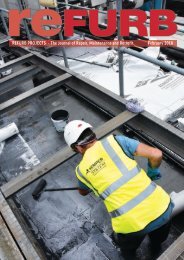Refurb Projects April 2017
Refurb Projects launched in 1987 to cater for the expanding Repair, Maintenance, Improvement and Refurb sectors of the UK Building Industry. Sustainability and the protection of the built environment are essential ingredients of the refurbishment market, and Refurb Projects Journal is a leader in reporting and promoting these ideals.
Refurb Projects launched in 1987 to cater for the expanding Repair, Maintenance, Improvement and Refurb sectors of the UK Building Industry.
Sustainability and the protection of the built environment are essential ingredients of the refurbishment market, and Refurb Projects Journal is a leader in reporting and promoting these ideals.
- No tags were found...
You also want an ePaper? Increase the reach of your titles
YUMPU automatically turns print PDFs into web optimized ePapers that Google loves.
CIF FUNDING<br />
How to apply for CIF<br />
and reduce your schools energy consumption<br />
Schools, academies and sixth-form colleges can obtain funding to improve the quality of<br />
buildings and premises via the CIF. Short for the Condition Improvement Fund, this<br />
government financial incentive is available annually via an online application process.<br />
The fund itself is designed to assist schools and colleges with health and safety issues,<br />
building compliance, improving energy efficiency and expansion projects.<br />
HOW DO SCHOOLS QUALIFY FOR<br />
THE CIF?<br />
For primary schools to be eligible for<br />
this grant, they need to have a<br />
minimum project demand of at least<br />
£20,000.<br />
This figure rises to £50,000 for<br />
secondary schools and colleges and<br />
the maximum that the government<br />
will assign to a project is £4<br />
million.<br />
Any money offered to successful<br />
applicants is ring-fenced solely for<br />
the improvement works, but the<br />
energy savings can free up<br />
additional financial resources for<br />
other demands within the school.<br />
APPLYING FOR THE CONDITION<br />
IMPROVEMENT FUND<br />
Applicants apply for the CIF online<br />
via the Education and Skills Funding<br />
Agency (ESFA) and attach<br />
supporting documentation as<br />
evidence to make their case as<br />
strong as possible.<br />
Each year, the application<br />
process consists of four main stages:<br />
1) Online application forms are<br />
available to complete on the ESFA<br />
website in October<br />
2) Applicants create an account on<br />
the ESFA CIF portal before<br />
November<br />
3) Application forms are submitted<br />
by December via the online portal<br />
4) Successful applicants are<br />
announced in March once they’ve<br />
been assessed<br />
Unsuccessful applicants can try<br />
to obtain private funding or go<br />
through the ESFA appeals process.<br />
ASSESSMENT CRITERIA FOR CIF<br />
APPLICANTS<br />
The three core areas that are used to<br />
determine whether a project is<br />
successful in its bid to obtain<br />
funding are:<br />
Project need (70%) – the<br />
evidence provided and a condition<br />
survey are the main factors in<br />
determining how funding is allotted,<br />
and health issues, such as heating or<br />
gas safety, take priority for the<br />
distribution of funds<br />
Project planning (15%) –<br />
applicants should detail the risks<br />
involved and showcase how the<br />
financial resources offered will<br />
resolve them<br />
Value for money (15%) – the<br />
breakdown of costs is assessed to see<br />
whether they meet the demands of<br />
the project<br />
RENEWABLE ENERGY IN<br />
REFURBISHED SCHOOLS<br />
Many schools use gas-fired systems,<br />
but a mixture of new technologies<br />
assisted by the fund can help to<br />
reduce energy consumption and<br />
carbon footprint levels significantly.<br />
EXAMPLES OF RENEWABLE<br />
ENERGY IN REFURBISHED<br />
SCHOOLS CAN INCLUDE:<br />
CHP (Combined Heat and Power) –<br />
this converts single fuel into both<br />
electricity and heat, which provides<br />
financial and environmental<br />
benefits.<br />
Its potential to be used as an<br />
efficient, complete heat source is<br />
greatest in bigger schools that<br />
require large volumes of hot water.<br />
In addition, schools can connect<br />
to district CHP schemes and it’s even<br />
possible to generate income from<br />
electricity tariffs when CHP is used<br />
on site.<br />
Air source heat pumps – heat is<br />
absorbed from the outside air and<br />
this can be used to heat radiators,<br />
underfloor heating and hot water.<br />
Ground source heat pumps –<br />
heat is extracted from pipes buried<br />
in the ground to heat radiators,<br />
water and air-heating systems.<br />
This method is ideal for reducing<br />
your carbon footprint and is even<br />
more powerful when used in<br />
conjunction with other solutions,<br />
such as improving insulation and<br />
windows.<br />
USING PROFESSIONAL<br />
CONTRACTORS<br />
If you’re looking to improve your<br />
own carbon footprint and make<br />
your school more energy-efficient,<br />
speak to professional contractors<br />
first.<br />
They will understand your project<br />
need and work out the correct path<br />
to take based on your individual<br />
project need.<br />
For more information about the<br />
school Condition Improvement Fund<br />
visit 361 Degrees.<br />
Web: www.361degrees.co.uk<br />
2 APRIL <strong>2017</strong>, REFURBISHMENT PROJECTS

















